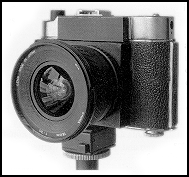By Hans Groffie
Note: This article is from the March 1997 Issue of PANORAMA Magazine. All photographs are by the author, ©1997 Hans Groffie.
I am a newcomer to IAPP, but an old hand at making 360 degree panoramic pictures. My 360 degree negatives date back to about 1965 and were then taken with my first panoramic contraption and a 35mm lens. It was rotated by hand on a tripod. The negatives were 222mm long – too long for a 4 x 5 enlarger. I did not like the long skinny format anyway and proceeded to make a panoramic camera with a 21mm Biogon (range-finder) lens. This camera was motor driven and radio controlled. The negatives were then only 135mm long and easy to enlarge.
 In early January of 1974, right after a heavy winter storm, I went to San Francisco. The sky was filled with puffy white clouds and Portsmouth Square was crowded with people. The salvation army band was playing and the men played checkers on the stone tables while others were soaking up the warm sun. This is photogenic China town. I set up the camera and pulled up the antenna while bystanders gathered around for a closer look. The salvation army band leader came over and asked if I was making a sound recording. I said that I was just making a picture and moved some distance away so I would not be in the picture myself. The onlookers were suddenly faced with a lens that turned in their direction. Some quickly turned their heads and others just stared in disbelief at that strange black rotating box with its tiny lens.
In early January of 1974, right after a heavy winter storm, I went to San Francisco. The sky was filled with puffy white clouds and Portsmouth Square was crowded with people. The salvation army band was playing and the men played checkers on the stone tables while others were soaking up the warm sun. This is photogenic China town. I set up the camera and pulled up the antenna while bystanders gathered around for a closer look. The salvation army band leader came over and asked if I was making a sound recording. I said that I was just making a picture and moved some distance away so I would not be in the picture myself. The onlookers were suddenly faced with a lens that turned in their direction. Some quickly turned their heads and others just stared in disbelief at that strange black rotating box with its tiny lens.
It is extremely difficult to find a scene that is pleasing all around without the sun shining in the lens. This camera had only one effective shutter speed of 1/20 so the movement of a foot becomes blurred. Also the camera was very heavy and cumbersome to set up. It was time for miniaturization. An 18mm Sigma was mounted on a discarded 2 1/4 camera body. The inside had just enough room for a panoramic conversion. In the picture (above) you can see that it is similar in size to a modern SLR. The negatives are now 114 mm long and 44 mm high. The picture of the Embarcadero Center in San Francisco was shot in color with this camera at Christmas time in 1994. The tiled paving in circular patterns hides all distortion in the foreground. I have kept long horizontal lines in the center of the picture. You can do this by raising or lowering the camera. To avoid the unsightly curving of obviously straight lines you must learn to visualize the actual photograph beforehand and select the scene very carefully. The location of the camera is absolutely crucial. The vertical angle of the 18mm lens is 100 degrees providing very prominent foregrounds that remain sharp due to the enormous depth of field of the 18mm focal length of the lens. It is unfortunate that the Sigma is not as sharp as the 21mm Biogon made in 1958. The 21mm is back in use again and mounted on another converted 2 1/4 body. This camera fits in my pants pocket and weighs complete with tripod less than 4 1/2 lbs.


All rights reserved and copyright of author.